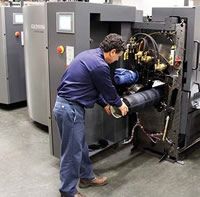PPM: When was the deal finalised and what does it mean in physical terms?
Leal Wright (LW): The effective date was June 1, and the entire Ferroprint operation is being moved from New Germany to our production site at Intersite Avenue in Umgeni Business Park, Durban.
PPM: How has this news been received by Ferroprint’s customers?
Devin Galtrey (DG): In the past, Ferroprint and Uniprint were fiercely competitive but customers have reacted very positively to the news. They like the idea of being serviced by a larger squad; and there’s a good vibe about the integration.
PPM: And how does this move affect the dynamics of the label market?
Reuben Glenny (RG): Our key strategy is growth and we’re driving this through acquisition. We’ve enjoyed good organic growth in the last year but overnight this move has significantly increased the size of our business. We’ve been pleasantly surprised at the level of excitement and enthusiasm from customers. They recognise that a more substantial operation has improved leverage, and that they should benefit from the resultant economies of scale.
Market conditions have been tough – and are getting tougher – but larger operations tend to be more stable in such circumstances. Additionally this acquisition sets us up for further growth and even more innovation.
LW: Part of the process was to prepare a submission for the Competition Commission, and this included a measurement of the local market. We identified the main players, key customers and markets, and the suppliers. This exercise showed us just how extensive the market is.
While the largest sector is pressure-sensitive labels, there’s also a significant market in wraparound and shrink sleeve labels. It’s a very diverse and extremely competitive market, with a great many entrepreneurs.
At the end of the day, the Commission approved the purchase because it is such a large and competitive market. It’s also clear that no one company really has ownership of any market sector, as different label suppliers specialise in different labelling technologies.
PPM: With the integration, what happens to the Ferroprint brand?
DG: We are definitely keeping the brand. Its strength warrants that and we will be monitoring the integration to see how the market copes. It’s important to provide continuity and a smooth transition. We don’t want to put established customers through a whole load of administrative changes regarding accounts, so it makes sense to keep things stable.
PPM: And what about Ferroprint’s equipment?
LR: We have a three-month plan to move the equipment. This has required significant investment into the building and infrastructure, especially the power supply and the layout of the printing and finishing halls. As a result, we now have better focus and a more streamlined workflow. And, as Ferroprint’s equipment is very similar to ours, the increase in capacity has been significant. We’ve also improved our flexibility and we’re covering our overheads across a broader base. That’s important in a market that’s feeling price pressures.
PPM: How is this affecting your management responsibilities?
RG: Well it’s a lot more work! With more people comes additional complexity. We have a larger sales team and an enhanced customer base, so we have to ensure watertight systems and processes.
But despite the fact that we’re a bigger operation, we still have to be close to our customers and provide the service they need. It’s going to be a challenge managing a larger team and covering all the bases. But it’s very exciting!
Devin Galtrey, Leal Wright and Reuben Glenny – excited about meeting the challenges of managing a much larger operation in terms of people and technology.










